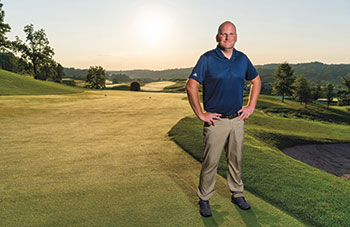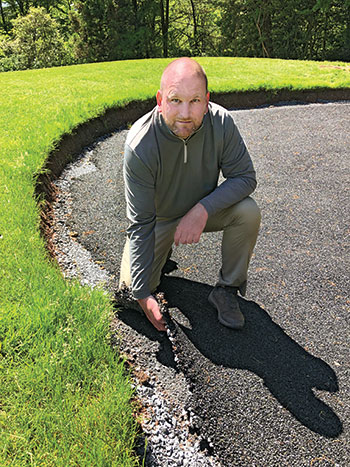2019 Herb Graffis Businessperson of the Year: Alan FitzGerald

Alan FitzGerald (Photo courtesy of Alan Fitzgerald)
The Herb Graffis Businessperson of the Year Award is named in honor of Golfdom’s founder, World Golf Hall of Fame member Herb Graffis. Graffis was one of the first people to think of golf as a business when he and his brother Joe founded Golfdom in 1927. With his foresight, Graffis helped advance the game in numerous ways, from founding the National Golf Foundation and the Club Managers Association of America to his work advocating on behalf of superintendents and elevating their profile.
The award includes a Golfdom cover story celebrating the honoree’s accomplishments, as well as expenses-paid trips to the Golfdom Summit and the Golf Industry Show. It is with all due respect that we present this award in Mr. Graffis’ honor.
Back in the early 1980s, a fellow named Victor Kiam made himself famous by going on television to sell Remington electric shavers. Like a car dealer, Kiam starred in his own commercials. In fact, his signature pitch line made him a minor celebrity: “I liked the shaver so much, I bought the company.”
Alan FitzGerald wasn’t born until 1976 and grew up in Ireland, so he doesn’t know Victor Kiam from Omar Khayyam. What’s more, he didn’t buy Blinder Bunker International. But after some 15 years of research, test bunkers and cost-benefit analyses, he believes he’s found the best bunker liner system out there. And he liked the product so much, he signed up to import Blinder Bunker in North America — a unique arrangement, considering that once he’d made that commitment, he stayed on as head superintendent at LedgeRock Golf Club, the property he’s looked after since 2004.

Alan Fitzgerald was really impressed with Blinder’s heavy, porous, seamless and flexible design. (Photo: Fernando Gaglianese)
While that arrangement is unique, the fact that he’s also gone into the venture 50-50 with LedgeRock Golf Club itself is even more unusual. It’s FitzGerald’s desire to keep LedgeRock looking pristine while also striving to make Blinder a success in the American market that has earned him the 2019 Herb Graffis Businessperson of the Year Award, awarded annually for eight years by Golfdom.
Jake Straub, who first met FitzGerald at Penn State “the day he walked off the airplane” from Ireland, says that the reason FitzGerald has been so successful is because he is always asking, “Why?”
“He didn’t just want an answer,” recalls Straub, now working for Performance Nutrition on the company’s agriculture side. “He’s outside the box. He still asks ‘Why?’ and as he’s gotten older, he also asks ‘Why not?’ And that’s a great thing.”
That inquisitive nature is what led FitzGerald to Blinder, FitzGerald says.
“I emailed (Blinder) out of the blue. That’s what I did with most of these companies selling the liner technologies,” FitzGerald recalls. “In that sense, the interaction was just the same: ‘Can you send me a sample? How do I get it here? What does it cost to get a crew over here?’ As it happened, it wasn’t cost prohibitive, and once I saw the product perform — honestly, the flexibility of the liner struck me as genius — I could see this was a real technological advance. So, I came back to them: ‘What if I imported it for you and you taught me how to do it? Would that work?’”
Blinder’s short answer was “Yes.” But leaving it there would gloss over and considerably shorten a pretty good, thoroughly trans-Atlantic story.
When Irish eyes are smiling
Wherever FitzGerald has found himself, he’s shown a remarkable ability to find work (and high-caliber professional training) at the finest, most ambitious golf facilities around. This naturally builds up the old résumé. It also tends to build up the diverse, real-world experience that sets elite golf course superintendents apart.
FitzGerald grew up in Castlecomer, in the southeast of Ireland. He was around the game all his life but never considered a career in golf until he took a summer job at Mount Juliet, the Jack Nicklaus-designed resort a half-hour from his home. There, he encountered Aidan O’Hara, CGCS, who had learned his trade, in part, at Muirfield Village in the other Dublin (Ohio), and whom FitzGerald and others credit for first bringing U.S. agronomic standards to Ireland.
“It was a magnificent place to work. Mt. Juliet was really one of the first two big resort developments in all of Ireland,” FitzGerald says, noting that The K Club is the other. “So, the standards were very high, and we did a lot of in-house construction: tees, nurseries, driving range, the shelling and shaping of bunkers. In a matter of two to three years, it felt like we’d built pretty much every feature of a golf course. We built an entire putting course at Mt. Juliet, 18 miniature USGA spec greens — with gravity-powered water features! It was not a formal education, but it was extensive.

LedgeRock was designed by Rees Jones and captures the essence of a classic old style course with scenic beauty and original landscapes. (Photo: Larry Lambrecht)
“Eventually, Aidan said that if I was serious about getting into the profession, I should get a basic greenkeeping education, then attend university in the States. That’s how I ended up at Penn State.”
He was 20 years old when he arrived in State College, his first trip to the United States. Eventually, he would earn a two-year turfgrass science degree under the watchful eye of George Hamilton, Ph.D. — and meet his Pocono-bred future wife, Jamie. After an internship at Loch Lomond in Scotland that first summer, “the stars aligned,” and he accepted an assistant-in-training position at Pine Valley Golf Club in Clementon, N.J., only the consensus No. 1 track on the planet.
“I think the world of Alan, he did a wonderful job here,” says longtime Pine Valley GC Superintendent Rick Christian. “He’s personable, and a hard worker — that’s why he is where he is today. He wanted to make it to the top and make himself better at the same time. He is always willing to learn and is always doing his research.”
The young Irishman, newly married, would eventually spend six years at Pine Valley. Then LedgeRock, a private Rees Jones signature design just breaking ground south of Reading, Pa., called.
Life on the Ledge
FitzGerald arrived at LedgeRock during the tree-clearing process, and despite his in-house construction credentials, was not expecting to be involved in building LedgeRock.

During the Great Recession, LedgeRock focused on a regional strategy to help broaden its membership base, though the course didn’t stabilize until 2011. (Photo: Larry Lambrecht)
“I wasn’t hired as any sort of construction superintendent. I was hired to be the golf course superintendent, to grow the course in,” he said. “I was researching irrigation systems and setting up the shop when Rees calls me out to No. 6 one day and asks me, ‘Will you be able to mow that bank? How will that work for you?’ We had that kind of relationship. It was great to be so involved.”
While Jones doesn’t recall that exact moment from 15 years ago, he does remember how easy it was — and still is — to work with the Irishman.
“Alan really knows how to relate to people,” Jones says. “That’s so important in today’s world. People have forgotten how to talk to people! That is as important today as growing grass.”
Jones notes FitzGerald’s pedigree, but adds that having Pine Valley on one’s résumé doesn’t do any good unless that superintendent can deliver. “Coming from a place like Pine Valley, there’s an expectation … and he’s fulfilled those expectations, because LedgeRock is as good as Pine Valley. He’s been (at LedgeRock) since the beginning … and they’re glad they hired him there.”
FitzGerald calls the workload back in those early days “completely nuts,” as the project manager left for a different project, and the weather refused to cooperate.
“I think we had 23 inches of rain that first July. We had a 100-year storm, then a 300-year storm — (a) pattern that seemed to repeat all summer. This is a very dramatic site topographically. We’d fix everything after a storm — and everything would just wash out again,” FitzGerald says with a shrug. “The tenacity of the founders was really amazing. They stayed with it, so that’s what we did as well.”
LedgeRock GC opened for play in June 2007. The Great Recession hit the following autumn, and private clubs started dropping like flies all over Pennsylvania and across the nation. But here again, LedgeRock’s founders showed great tenacity.
Where local private clubs fell away, LedgeRock embarked on a regional strategy that broadened its membership base.
Indeed, things didn’t stabilize for FitzGerald and LedgeRock until about 2011. With those seven years of relative chaos behind them, the superintendent knew it was time to address two issues of primary importance: the club’s perennially contaminated bunkers and his pending dual citizenship.
“I’m going through the U.S. citizenship process right now,” FitzGerald says with a wry smile. “I wouldn’t say I’ve procrastinated on it, but I could’ve done it sooner … It was a handy excuse to get out of jury duty.”
A faith in Blinder
The bunkers at LedgeRock couldn’t wait that long.
“The bunkers here regularly washed from the time the sand went into them. For the first few years, the maintenance staff did a great job removing the contaminants, but eventually it got to the point where the sand needed replacing,” FitzGerald says. “My standing joke has been, ‘The members here have never played in brand-new bunkers.’”
In 2005, when FitzGerald first pondered how to address the continuing washout issue, bunker-liner technology was still in its infancy.
“During construction here at LedgeRock, fabric liners were the only things on the market, really. We priced them out and looked into it seriously. But the benefits versus the costs didn’t make it worthwhile, in my opinion,” FitzGerald says. “The cost/benefit analysis I made back then is really the same analysis every superintendent must make today — even 15 years later, with the development of so many additional technologies: fabric liners on their own, polymer-sprayed gravel, porous asphalt, concrete or Blinder’s flexible crumb-rubber/polymer mix. It’s a big investment no matter what product you choose, so it’s got to last.
“Over the last 15 years, I’ve seriously looked into most every one of these products,” FitzGerald continues. “Each one has their strong and weak points. Cost is a massive issue. It’s also hard to come by the aggregates you need in some cases.”
In general, FitzGerald believes the bunker liner product universe can be broken into two broad categories: soft (fabric liners) and hard (aggregate liners). That’s ultimately why he was drawn to the Blinder product, which, in his opinion, creates an all-new third category with its heavy, porous, seamless and flexible design.
“Essentially, the base is compactable road stone, a solid, consistent surface that water runs along and does not penetrate,” he says. “The rubber is mixed with a polymer and hand-laid into place to ensure it closely follows the contours of the bunker. Water flows right through that layer. It’s seamless, and being rubber, it’s just more flexible than anything else. You could roll it up like a carpet if you had a big enough lift.”
Blinder has been operating in Europe for a decade, where, unlike in North America, it’s one of the most recognizable names in bunker liners. According to FitzGerald, in 10 years and more than 1,000 bunkers, there have been zero failures.
“Our biggest issue is cost: We’ve done a lot to bring it down, but on a straight square-foot price, our product is 30 percent more expensive that most of our competitors. That’s due to the cost of the raw materials — and that we install it. And we pretty much refuse to compromise on quality, which justifies the long-term investment prospect, in our view. These bunkers just do not fail,” FitzGerald says.
It’s perhaps no surprise that FitzGerald believes in the Blinder product; on some level, every entrepreneurial venture requires that belief.
More surprising, perhaps, is his full-time employer’s belief in the venture.
LedgeRock General Manager Gerry Heller, a 25-year golf hospitality veteran, recognizes that the arrangement with FitzGerald and Blinder is unique. But he sees it as eminently sensible, as well.
“Alan was totally upfront with us about this, and we frankly viewed it as an opportunity — for him as a valued employee and for us as a club,” Heller says. “We haven’t made any real money on this venture yet. But we haven’t lost any either. Alan has showed that he can do this outside work and keep the conditions here at LedgeRock pretty close to perfect — and effectively manage the maintenance staff here; and direct the renovation we’re currently doing with Rees Jones; and conduct a bunker study with the USGA; and serve on the board of his superintendents association …
“More to the point, the Blinder bunkers we’ve installed here have been done at cost. That’s what the club gets out of it, and we see that as a pretty good deal.”
Most recently, Blinder outfitted all the bunkers at Skippack GC in Eastern Pennsylvania, but FitzGerald is clear-eyed about the challenges ahead. “We have to do a lot more volume in order to make any real money. But we’re getting there.”
And he remains philosophical about how this outside business project plays into his natural ability to multitask — a trait most superintendents develop early in their careers.
“As it is,” he says, “I’d say 97 percent of my day is still centered on LedgeRock and day-to-day maintenance operations and the renovation we have going here. The Blinder business accounts for the other 3 percent, but because it’s all above board, fielding a Blinder call in the middle of the day is seamless and unremarkable, to be honest.
“I don’t see a reason why other superintendents couldn’t swing the same sort of arrangement, if the right opportunity comes up. The big thing, obviously, is to be sure the club is on board. There has to be something in it for them. The secondary thing is, if the club said, ‘No way,’ you have to be prepared for that and have a Plan B. If you don’t, it would get real awkward, real fast.”











